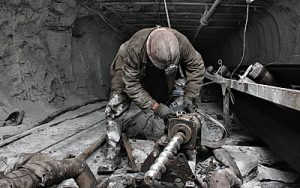Mining

Due to the high risk of developing TB in the mines, all underground workers are screened at least once a year for TB and a biennial radiograph is carried out.
Primary health challenges vary from sector to sector. According to the Chamber of Mines noise induced hearing loss (NIHL) is a health risk in almost all areas of mining, as it is in all forms of industry.
Occupational lung disease, particularly silicosis, is a major issue also in the gold and coal sectors. All these are classified as compensable occupational health illnesses.
Both pulmonary tuberculosis (TB) and HIV/AIDS are significant public health threats in southern Africa, with often debilitating and potentially life-threatening consequences for employees and their communities. Where TB develops in the presence of silica dust exposure, this also becomes an occupational illness.
Supporting Vision Zero
Vision Zero is a global prevention strategy developed by ISSA, targeting a working environment in which nobody is injured, killed or falls so severely ill that she or he suffers lifelong harm. The NIOH supports Vision Zero in the mining industry and in fact all sectors of the economy including the informal economy both in South Africa and throughout Africa. The prevention of occupational injury and disease is paramount.
Please visit the Vision Zero page on the MIASA website to learn more about this comprehensive framework for addressing health and safety in a systemic way.
TB and Silicosis
Silicosis is an occupational lung disease caused by inhalation of silicon dioxide in crystalline forms such as quartz, cristobalite or tridymite. Workers at greatest risk are those who blast rock and sand such as miners, quarry workers and stone cutters. People with silicosis have a significantly increased risk of developing active tuberculosis. The often quoted figures are that mineworkers with silicosis are six times more likely to develop active TB, and mineworkers with silicosis and HIV are eighteen times more likely to develop active TB. Silica dust is considered to be a risk factor for the development of pulmonary TB.
Due to the high risk of developing TB in the mines, all underground workers are screened at least once a year for TB and a biennial radiograph is carried out. Mining can be arduous work in challenging and potentially hazardous circumstances; the South Africa’s mining environment is unique and exceptionally challenging. Certain mines operate up to five kilometres underground where the virgin rock temperatures can reach 60°C. In these and other circumstances, the safety of mine workers must take priority.
The Introduction of South Africa’s Mine Health and Safety Act (MHSA) in 2006, was considered to be fairly radical in its time, as it made provision for a tripartite approach to safety and health that requires industry, the trade unions and government to act in cohesion in promoting a safe and healthy workplace.
Establishing A Centre Of Excellence
In 2014, the Mine Health and Safety Council (MHSC) principal tripartite stakeholders launched a Centre of Excellence (CoE) to conduct world-class research, build research capacity and facilitate the implementation of research outcomes.
Surveillance
The Pathology Division’s PATHAUT report provides disease surveillance data for the mining industry and assists in monitoring disease trends. This can demonstrate areas of success and improvement within the industry. It has also functioned to guide the assessment of occupational hygiene standards and set levels of impairment.
Related Materials
- HSE UK – Vibration at work
- HSE UK – Controlling the risks from Hand Arm Vibration
- HSE UK – Silica – reducing exposures in the workplace
- HSE UK – Noise
- HSE UK – Musculoskeletal Disorders
- WorkSafe New Zealand – Excavation Safety
- WHO – Silicosis related information
- MBOD – Compensation procedure
- Chamber of Mines
- Department of Mineral Resources (DMR)
